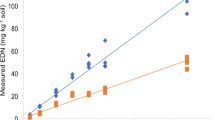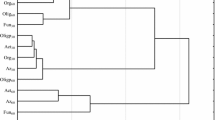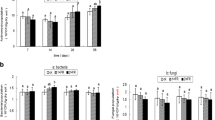Abstract
Pesticides were added to soil at a rate of 10 mg/kg and then planted with corn, wheat, or bean seeds. Captan and thiram caused an initial decrease in the fungal populations but by 108 days the populations returned to levels found in untreated soils. The bacterial populations fluctuated inversely with the fungal populations. In soil planted with corn, atrazine had no effect on the microbial populations, however, in soil containing wheat and beans, populations of fungi and bacteria increased. Stimulation of the microbial populations in the atrazine-treated soils was attributed to the decay of the dead wheat and bean plants. Atrazine in combination with captan or thiram had neither synergistic nor antagonistic effects on the microbial populations.
Similar content being viewed by others
Literature Cited
Bates, J. J., The effect of herbicide-fungicide combinations on soil bacteria and fungi in treated soil and in treated cultures. M.S. Thesis, University of Missouri, Columbia. 58 pp. (1969).
Bollen W. B., Interactions between pesticides and soil microorganisms. Ann. Rev. Microbiol. 15, 69–92 (1961).
Burchfield H. P., Comparative stabilities of Dyrene, 1-fluoro-2,4,-dinitrobenzene, dichlone and captan in a silt loam soil. Contr. Boyce Thompson Inst. 20, 205–215 (1959).
Corbin, F. T., and Sheets, T. J., Antagonistic effects of certain pesticide combinations on plants. Weed Abstracts p. 22 (1968).
Deems, R. E., Black root of sugar beets as influenced by various cropping sequences and their associated microfloras. Ph.D. Dissertation. Ohio State University, Columbus, 217 pp. (1956).
Domsch H. K., Soil fungicides. Ann Rev. Phytopathol. 2, 293 (1964).
Georgopoulos S. G., and Zaracovitis C., Tolerance of fungi to organic fungicides. Ann. Rev. Phytopathol. 5, 109–130 (1967).
Herr L. J., Soil mycoflora associated with continuous cropping of corn, oats, and wheat. Ohio J. Sci. 57, 203–210 (1957).
Kaufman D. D., Effect of s-triazine and phenylurea herbicides on soil fungi in corn- and soybean-cropped soil. Phytopathol. 54, 897 (Abstr.) (1964).
Nash, R. G., and Harris, W. G., Dexon fungicide antagonism toward herbicidal activity of s-triazine. Weed Sci. Soc. Am. Abstr. No. 240 (1969).
Richardson L. T., Effect of insecticide-fungicide combinations on emergence of peas and growth of damping-off fungi. Plant Diseases Reptr. 44, 104–108 (1960).
Webster, H. L., and Sheets, T. J., A physiological explanation of the atrazine-Dexon interaction. Weed Sci. Soc. Am. Abstr. No. 239 (1969).
Author information
Authors and Affiliations
Additional information
This study was supported by Public Health Service Research Grant No. CC 00284, from the National Communicable Disease Center, Atlanta, Georgia.
This study was supported by Public Health Service Research Grant No. CC 00284, from the National Communicable Disease Center, Atlanta, Georgia.
Rights and permissions
About this article
Cite this article
Houseworth, L.D., Tweedy, B.G. Effect of atrazine in combination with captan or thiram upon fungal and bacterial populations in the soil. Plant Soil 38, 493–500 (1973). https://doi.org/10.1007/BF00010689
Issue Date:
DOI: https://doi.org/10.1007/BF00010689




